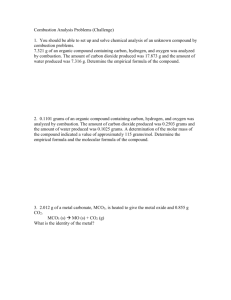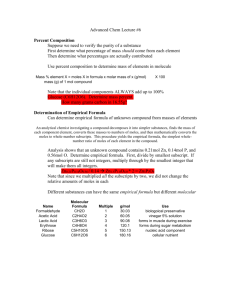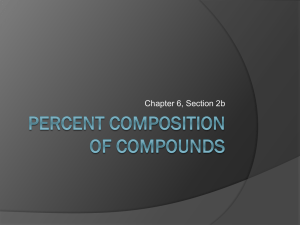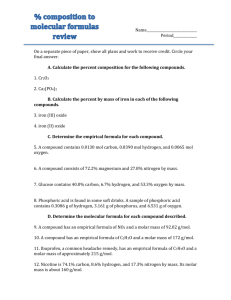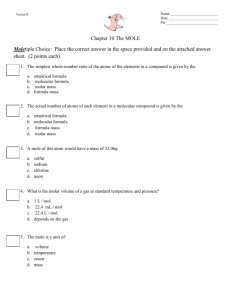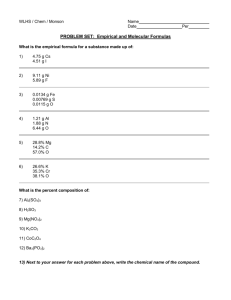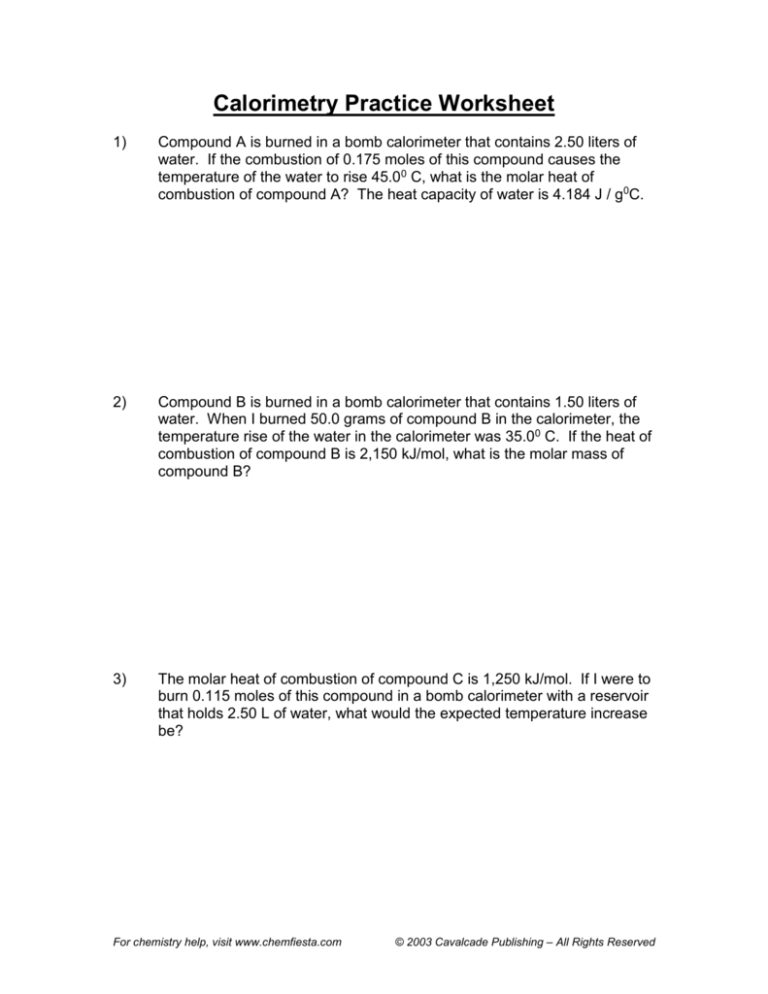
Calorimetry Practice Worksheet
1)
Compound A is burned in a bomb calorimeter that contains 2.50 liters of
water. If the combustion of 0.175 moles of this compound causes the
temperature of the water to rise 45.00 C, what is the molar heat of
combustion of compound A? The heat capacity of water is 4.184 J / g0C.
2)
Compound B is burned in a bomb calorimeter that contains 1.50 liters of
water. When I burned 50.0 grams of compound B in the calorimeter, the
temperature rise of the water in the calorimeter was 35.00 C. If the heat of
combustion of compound B is 2,150 kJ/mol, what is the molar mass of
compound B?
3)
The molar heat of combustion of compound C is 1,250 kJ/mol. If I were to
burn 0.115 moles of this compound in a bomb calorimeter with a reservoir
that holds 2.50 L of water, what would the expected temperature increase
be?
For chemistry help, visit www.chemfiesta.com
© 2003 Cavalcade Publishing – All Rights Reserved
Calorimetry Practice Worksheet
1)
Compound A is burned in a bomb calorimeter that contains 2.50 liters of
water. If the combustion of 0.175 moles of this compound causes the
temperature of the water to rise 45.00 C, what is the molar heat of
combustion of compound A?
H = (2.50 x
H = mCpT
g H2O)(4.184 J/g0C)(45.00 C)
H = 471,000 J
103
Because 471 kJ of energy are given of when 0.175 moles of
compound A burn, we can divide 471 kJ/0.175 mol to find that the
molar heat of combustion of compound A is 2.70 x 103 kJ/mol.
2)
Compound B is burned in a bomb calorimeter that contains 1.50 liters of
water. When I burned 50.0 grams of compound B in the calorimeter, the
temperature rise of the water in the calorimeter was 35.00 C. If the heat of
combustion of compound B is 2,150 kJ/mol, what is the molar mass of
compound B?
H = mCpT
H = (1.50 x
g H2O)(4.184 J/g0C)(35.00 C)
H = 2.20 x 105 J
103
Because the molar heat of combustion of this compound is 2,150,000
J, we can determine the number of moles of compound that were
burned by dividing the amount of heat generated in the calorimeter
by the molar heat of combustion. (2.20 x 105 J / 2.15 x 106 J/mol) =
0.102 mol.
If 0.102 mol of compound B weighs 55.0 grams, the molar mass of
compound B is 55.0 grams/0.102 mol = 539 g/mol.
3)
The molar heat of combustion of compound C is 1,250 kJ/mol. If I were to
burn 0.115 moles of this compound in a bomb calorimeter with a reservoir
that holds 2.50 L of water, what would the expected temperature increase
be?
Because 0.115 moles of the compound are burned, we would expect
the amount of heat given off to be equal to 0.115 mol x 1,250 kJ/mol =
144 kJ. Putting this into our equation:
H = mCpT
144,000 J = (2.50 x 103 g H2O)(4.184 J/g0C)(x)
x = 13.80 C
For chemistry help, visit www.chemfiesta.com
© 2003 Cavalcade Publishing – All Rights Reserved



